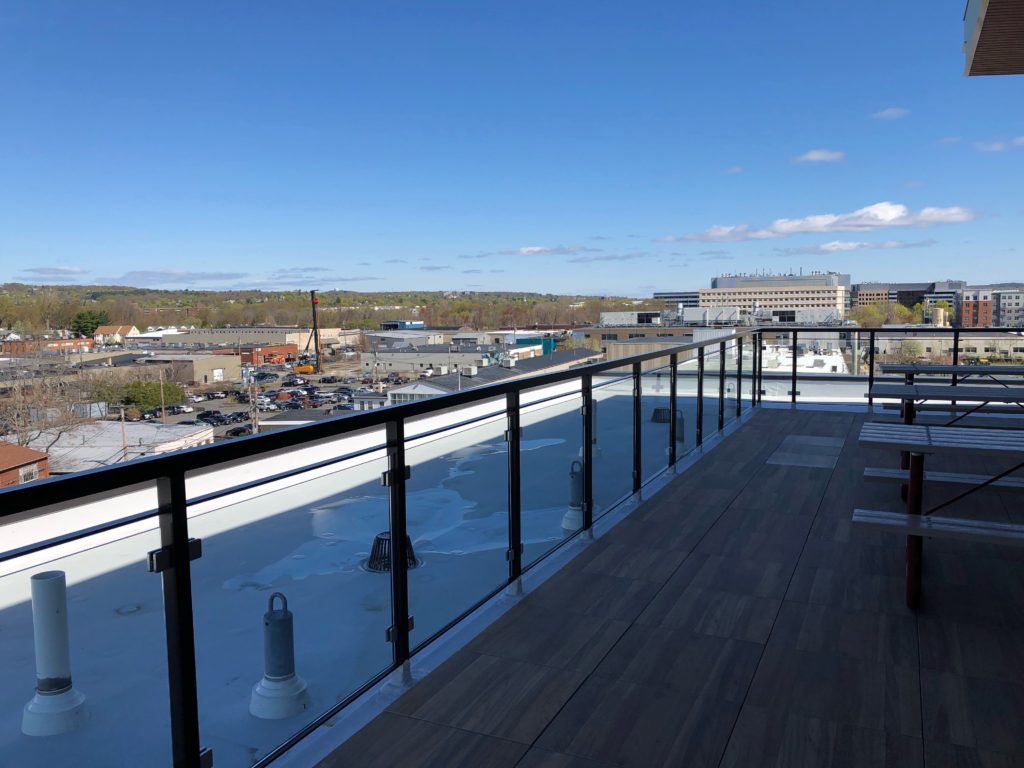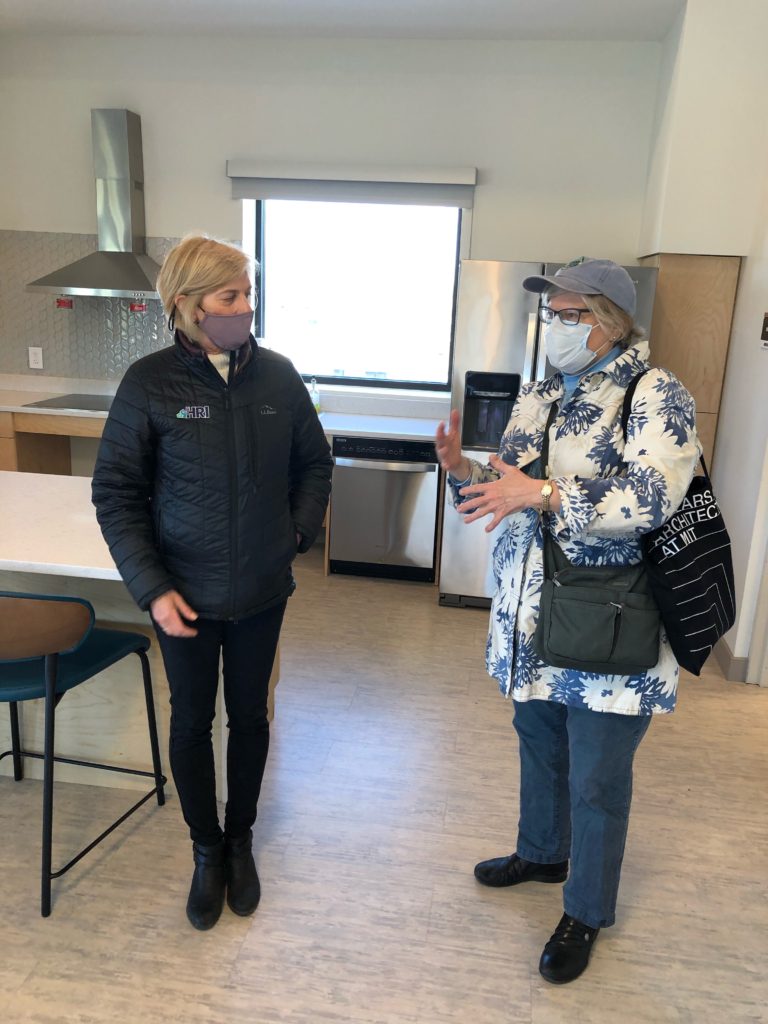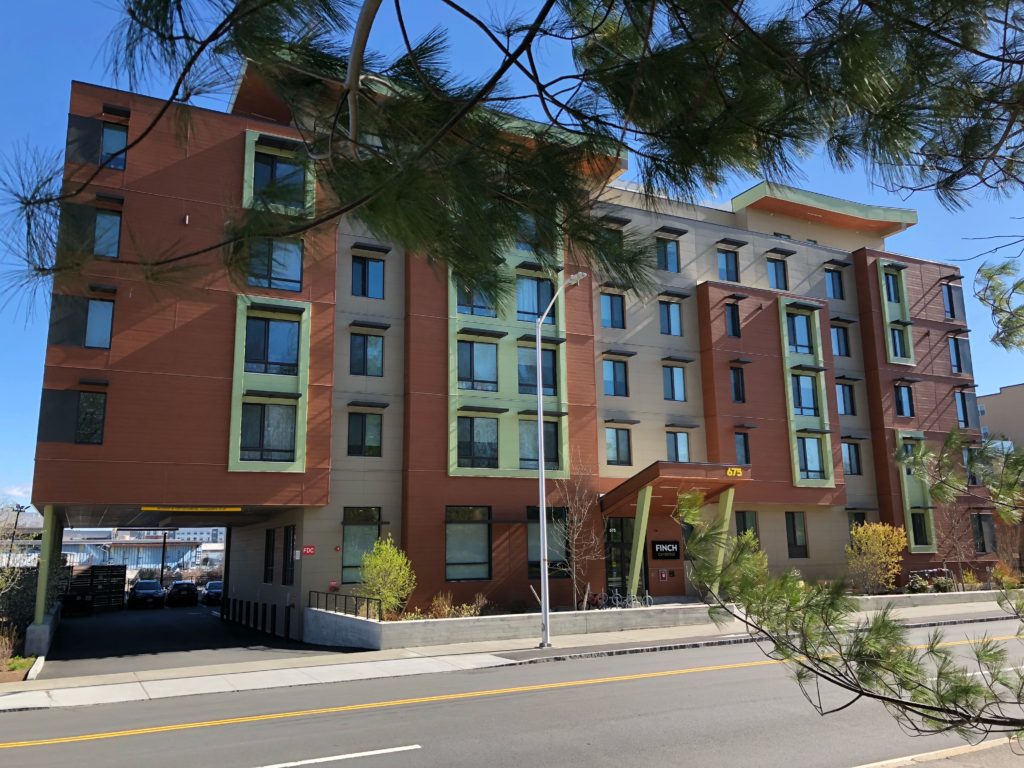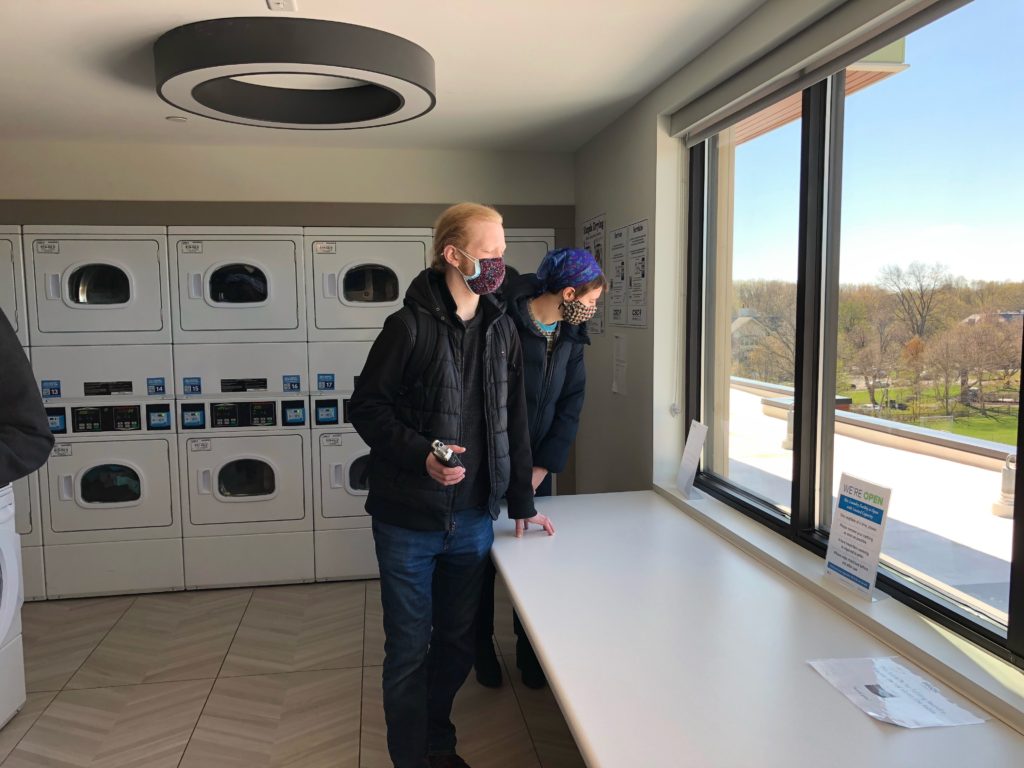 The view from the Alewife neighborhood of Cambridge from the roof deck of Finch
The view from the Alewife neighborhood of Cambridge from the roof deck of Finch
Join Host Kimberly Vermeer for the story of Finch, the largest new construction affordable housing development in Cambridge, MA in the last 40 years. This episode recounts how Jane Carbone (Director of Development, Homeowners Rehab) and Michelle Apigian (Associate Principal, Icon Architecture) reconciled the ambitious requirements of three leading certifications: Enterprise Green Communities, FitWel and Passive House US as they designed and built Finch. Through collaboration, the team was able to navigate the energy performance and tight building envelope required by Passive House, along with the openness and connectivity associated with FitWel. Not to mention – they built and opened Finch during the Coronavirus pandemic! This episode includes soundscapes from a tour of Finch and a jaunt at Fresh Pond Reservation, Cambridge’s water reservoir just across the street.
Note: Special thanks to Finch resident Barbara who graciously gave us a tour of her home!
Topics Discussed:
Resources:
 Jane and Kim chat in the community room
Jane and Kim chat in the community room
 The exterior of Finch
The exterior of Finch
 Carl-Isaak and Klara check out the views from the laundry room
Carl-Isaak and Klara check out the views from the laundry room
JANE CARBONE: We wanted to make this like a cool place, just that the kids would say, “I live at Finch,” and be proud of it, because I think where people live, it impacts how they think about their whole lives. And, you know, it’s a safe haven. And so we really wanted to create that here as well.
[Intro Music]
KIMBERLY VERMEER: Hello! I’m Kim Vermeer, host of Green in Action, the podcast where we celebrate green leadership in affordable housing.
You just heard from Jane Carbone, Finch developer.
JANE CARBONE: I’m the director of development at Homeowners Rehab in Cambridge, and we’re a housing nonprofit developer that has been around for about over 40 years doing housing development in Cambridge.
KIMBERLY VERMEER: For this episode of Green in Action, we stayed close to home. We’re excited to have Jane and her collaborator, architect Michelle Apigian, share the story of Finch, a new affordable housing development in densely developed Cambridge, Massachusetts.
MICHELLE APIGIAN: I’m Michelle Apigian, I’m an associate principal at Icon Architecture. We are a woman-owned Boston-based design firm focused on sustainable community at a variety of scales and a variety of project types.
KIMBERLY VERMEER: Homeowners Rehab and Icon Architecture worked together on Finch, which is the largest new construction affordable development in Cambridge in the last 40 years.
JANE CARBONE: We wanted to achieve a highly efficient new construction development. And so Finch became our prototype. And it’s 98 units. It’s on the Fresh Pond on Concord Ave. in the Fresh Pond neighborhood of Cambridge. And it’s a mixture of family housing. So it’s one, two and three-bedroom units. And we have about two hundred forty-two residents there, it’s all affordable.
KIMBERLY VERMEER: Finch offers much needed housing, and is special in many ways. Not only is it affordable, it’s also very green. And to prove it, the project achieved Enterprise Green Communities and Passive House certification. Jane also decided to pursue FitWel certification to keep health as a priority for the team.
The Green in Action team, Klara Kaufman, Carl-Isaak Krulewitch, and I, took a field trip across the Charles River to check out this ambitious project in person.
KIMBERLY VERMEER (Site Visit): Ah, we’re walking the path at Fresh Pond, the reservation right across the street from Finch. Today, it’s windy, but it’s so beautiful to be out in nature and it’s so close to Finch and near a busy street, but we can very quickly get to a place where it’s quiet and calm and we’re near, out in nature.
KIMBERLY VERMEER: After a walk by the pond, we crossed the street to meet up with Jane and Dan Thompkins, the Senior Property Manager at Finch.
KIMBERLY VERMEER (Site Visit): Oh, hi Dan. Nice to meet you.
DAN THOMPKINS (Site Visit): Nice to meet you too.
JANE CARBONE (Site Visit): So, Dan said he would help us with the tour.
KIMBERLY VERMEER (Site Visit): Oh awesome, awesome.
KIMBERLY VERMEER: One of the first stops on our tour was the lobby.
KIMBERLY VERMEER (Site Visit): Here we are in the beautiful lobby of Finch…
DAN THOMPKINS (Site Visit): Fantastic lobby.
KIMBERLY VERMEER (Site Visit): Just really nice, beautiful artwork on the main wall, nice tile floor and a stairwell that leads up to the second story.
KIMBERLY VERMEER: The building is beautifully designed, inside and out: we loved seeing it in person. As Jane and Dan led us through the building, it really felt like the Finch development team had done it all – even accomplishing goals that might seem to be at odds.
JANE CARBONE: So we’re trying to marry all these issues that are on a more global sense and try to identify and make an impact on a smaller scale on this development. Our developments are just beautiful places to live. And I think we took a lot of the stigma of what people think of affordable housing by showing people what our developments look like.
KIMBERLY VERMEER Through collaboration and persistence, the team was able to build at scale in a very tight land market; meeting city and budget requirements. They developed a building using both green and health certifications. They prioritized accessing nature and creating generous common spaces for all residents, even in a dense urban setting. And not to mention, that they opened Finch in the middle of the coronavirus pandemic!
KIMBERLY VERMEER: Join me on this episode of Green in Action to learn how Homeowner’s Rehab and Icon Architecture were able to build this ambitious project by working together to reconcile these tensions, achieving more than they could have imagined when they began.
[Music]
KIMBERLY VERMEER: HRI faced challenges from the start. Just building an affordable housing development in Cambridge is difficult, where there’s very little space for new development. But, as Jane explained:
JANE CARBONE: The city of Cambridge has the affordable housing overlay, which is the opportunity that you can create housing in in any neighborhood in Cambridge.
KIMBERLY VERMEER: With the support of the city, HRI had the opportunity to acquire the sites of a former gas station and a landscaping supply company in North Cambridge. Under development pressure from the biotech industry and luxury housing developers, many industrial companies in that neighborhood are closing and selling their properties.
Next, once they owned the land, it was on to entitlements. The city has progressive building and zoning codes that require a lot from developers. Michelle shared how those codes impacted climate resilience.
MICHELLE APIGIAN: We wanted to get the building base elevation for even the lobby, but certainly the residences, above the 2070 floodplain. And this was important for resilience. It’s important to the city. It’s clearly important to the residents. But we also had a certain unit count that really made everything work. And so we had to lift the building, but we needed to be just under a certain height, in terms of the building code.
KIMBERLY VERMEER: Building above the floodplain but below the building code height limit required creative thinking – both for design and for the budget.
They had to consider parking requirements, too. In Cambridge, the rule is to provide one parking spot for every unit in a project. But they didn’t have room for a 100-unit parking garage.
JANE CARBONE: We could show that data, that in this population people use fewer cars and rely more on public transportation. So they granted that relief. And then the city is really trying to promote alternative transportation. So with that reduction in parking, they added a requirement to have one-for-one bike parking.
KIMBERLY VERMEER: With the reduction of car parking requirements, the team was able to provide 101 bike parking spots instead. They also agreed to provide a van shuttle to the nearby Alewife MBTA transit station.
The city also had a new resiliency standard to combat the problem of combined sewer overflow during severe rainstorms. By requiring on-site waste storage, the chance of sewage mixing with rain water during a big storm is reduced.
JANE CARBONE: We had to create an eight-thousand-gallon storage tank to collect waste in the event of a storm event. And then we have another CULTEC system to collect rainwater. And those are very expensive elements to design and to build and maintain. And the city has been very generous in helping us support and fund those improvements that we’re making. And again, because that is impacting their climate goals and the climate resilience measures that they want to have for new construction in the neighborhood and in the whole city.
KIMBERLY VERMEER: A robust community engagement process throughout the planning and permitting helped to secure the support of the city and the Concord Highland neighborhood.
JANE CARBONE: Getting the community involved early on, getting their ideas and then creating a really good housing development, that not only works for the people that live there, but also the neighborhood as well.
KIMBERLY VERMEER: With all these challenges of planning and permitting, the team had their work cut out for them. But Homeowners Rehab is committed to building green on every project. They are not resting on their laurels!
[Music]
JANE CARBONE: In our last new construction project we achieved LEED Platinum. But Finch gave us the opportunity to go a little further.
KIMBERLY VERMEER: HRI wanted to build a project that was both sustainable and health-oriented. They decided to pursue Enterprise Green Communities and FitWel certification. FitWel is a health-centered design rating system.
In order to do that, all the project partners had to be on board with that mission. But Michelle knew what she was signing up for.
MICHELLE APIGIAN: We’d worked with HRI before. And at every step they were raising the bar and we wanted to join them in that endeavor. So it’s sort of high performance, meet all the goals, but let’s make sure that we can afford to build it, right. And that’s that ultimately is the balancing act.
KIMBERLY VERMEER: HRI also hired a contractor early on, NEI General Contracting, a firm they had worked with on prior projects.
MICHELLE APIGIAN: I mean, we were lucky in that I think NEI was with us. They understood our goals and they were pricing it with sincerity, which I think is really important.
KIMBERLY VERMEER: In pursuing their climate resilience goals, the team focused on Passive House design principles as their benchmark for going above and beyond Green Communities requirements. Passive House requires a well-insulated building envelope, and really good ventilation. And as a result, it needs very little heating and cooling, so buildings are very energy efficient.
MICHELLE APIGIAN: From the get-go, my goal was to design it as close to Passive House as we could, recognizing that there might be a cost premium and this project needed to be able to get built. So aim high, and see if we’re able to get there by being really laser focused on what’s critical to achieving a Passive House-level building, a really, truly low energy building, that’s airtight.
KIMBERLY VERMEER: As Michelle described, initially, they were more concerned with building an energy efficient building, rather than achieving an official Passive House certification, something that can be challenging to accomplish.
JANE CARBONE: We incorporated many features that were we called Stealth Passive House. But then the opportunity came up to go Passive House certified through the Mass CEC grant program. So we were in construction documents and we kind of switched gears to design to passive house standards.
KIMBERLY VERMEER: With the Mass Clean Energy Center’s Passive House pilot program funding, the team was able to make that leap, and get Passive House certified.
While a “stealth” approach to certification can be useful, both Jane and Michelle agree that in most cases, it’s better to get certified for real.
JANE CARBONE: That’s how you are going to know that the building that’s on paper is really being designed and then the end goal of operations will not be problematic.
MICHELLE APIGIAN: Testing and verification is critical, and having a third party do some of that quality control — and certification is the best way to ensure that that happens. It really enlightened owner or a team with experience could probably do without certification, but you still can’t do without all the testing and everything else that’s required to get certified. So if you’re going to do that, then I would just say go all the way.
KIMBERLY VERMEER: But before Passive House certification became a reality – in order to meet their healthy housing goals, the team had decided to pursue a FitWel certification. FitWel is a rating system from the Center for Active Design that addresses health as an interconnected system.
JANE CARBONE: The Center for Active Design had sort of a checklist on how to make your developments more active and making staircases attractive, adding artwork or adding additional lighting, more windows, creating space for programs and classes. And so, they partnered with FitWel and developed this certification.
KIMBERLY VERMEER: In designing Finch, they designed for Fitwel standards like occupant safety, access to healthy foods, increased physical activity, community health, and general feelings of well-being.
JANE CARBONE: I think it’s really important for us to not just provide housing for the resident, but also create opportunities to improve the health and wellness of our residents. And a lot of times in the past, people have had high levels of asthma due to poor indoor air quality or poor materials. And I think we are trying to create housing that doesn’t have those health impacts.
KIMBERLY VERMEER: Providing common areas that benefited all residents was crucial to community health.
MICHELLE APIGIAN: Folks might have their kids studying in a study nook while someone’s doing laundry and someone else is out in the garden on the roof deck.
JANE CARBONE: We have created a meandering pathway around the property with a little pocket park, Access to larger open space and alternative transportation. So we have the bike parking and we also have equipment for people to change their tires and pump up the air in their tires and just maintain their bikes. We have a farmer’s market that comes to the property so that we could have it in the lobby for residents, or we could have it upstairs in the community room.
MICHELLE APIGIAN: Active design is a mindset of creating an environment inside and outside the building where people are encouraged to move and walk, not take the kind of simple solution, the elevator, for example, and they’re given opportunities to do that that are pleasant and that’s what encourages them to do it. So Jane had a real vision that the lobby needed an open stair that would connect into the building and be visible far before you got to the elevator.
KIMBERLY VERMEER: But Passive House and FitWel don’t always play nicely together. Passive House standards require an airtight building envelope, but Fitwel looks for inviting open spaces and encouraging physical connections between those spaces. These priorities seem incompatible!
MICHELLE APIGIAN: “The Passive House works because it’s airtight and therefore separate on some level. And yet we wanted deep connectivity in the building, whether physical connectivity, visual connectivity. So how to create a sense of openness and bringing people through the space while maintaining an airtight boundary was a real challenge.
KIMBERLY VERMEER: Jane wanted the lobby to be open and inviting, a place where they could host farmer’s markets and community events. But that openness wasn’t going to work with Passive House requirements.
MICHELLE APIGIAN: Many points when people are moving in or out, the doors are just wide open. And whatever is happening is going to be flying into the lobby. And we wanted to make sure that that wasn’t affecting what’s happening in the residential portion of the building.
KIMBERLY VERMEER: The team resolved this by defining the line of the Passive House envelope very clearly – and excluding the lobby from that envelope. A team approach was critical to tackling those complexities.
JANE CARBONE: We really wanted to create a development that was more resilient as well as sustainable and Passive House really creates those features. There are active design features incorporated in the building. So people take the stairs rather than the elevator and we wanted to not just build a building, but create, in essence, moments where people could connect with the environment.
[Music]
KIMBERLY VERMEER: Creating an environment where residents can connect with each other and with staff always takes thoughtfulness. But the team carefully considered green fundamentals too, like excellent ventilation. The building has a balanced energy recovery ventilation, or ERV system, that turned out to be important in addressing health needs during the pandemic.
MICHELLE APIGIAN: I’m just delighted that we have an ERV that’s providing continuous balanced ventilation, to every unit, to every major space in every unit and exhausting continuously, and there’s no overlap in that air. And so these are MERV-13 filters. As we read the ongoing evolution of the CDC’s recommendations. We’ve got what they’re recommending and that, you know, that comes from a Passive House approach. So I just I feel great about that. It is not OK to tighten up our buildings without having continuous intentional balanced ventilation. I cannot say it enough.
KIMBERLY VERMEER: When deciding on heating and cooling systems, in addition to resident comfort, Jane wanted to consider climate resilience and carbon emission reductions. That meant looking at going all-electric.
JANE CARBONE: We had the engineer, he prepared a detailed memo looking at all the different options; if we went with the central boiler or ductless mini-splits or VRFs or heat pumps. And so he put that list together. And then we were able to get our contractor to give us quotes on what each system would cost. And then we looked at the benefits of each system.
MICHELLE APIGIAN: I think it’s typical for heat to be covered as a part of your rent, but not cooling. If you’re doing a central system. The owner would be paying for both heating and cooling.
KIMBERLY VERMEER: After considering the pros and cons of the options presented by the engineer, HRI decided to install a central variable refrigerant flow, or VRF system, even though a central system meant they would be paying for heating and cooling within the apartments.
MICHELLE APIGIAN: From a physical perspective, that also opened up a couple of terrific opportunities. One, we had much less equipment on the roof, which gave us room for one hundred- and five-KW PV array. And if we’d had individual condensers for every one of those ninety-eight residents, we’d have a substantially less real estate on the roof. So that’s one benefit. And the other is that it’s a simultaneous system, which means that it could be heating in one unit and cooling in another unit at the same time.
KIMBERLY VERMEER: Being able to have heating in one unit and cooling in another at the same time is benefit of VRF systems and a big contributor to resident comfort. And, as Michelle pointed out, thanks to that VRF system, there was more room on the roof for a PV solar electric array, so the building could produce more of its own energy. And, as it turned out, other green features such as great ventilation made the building more resilient when facing a pandemic. On our site visit, we got a chance to see how HRI was navigating Covid-19 at Finch.
KIMBERLY VERMEER: Finch opened in July 2020, so residents were moving in during a time of strict Covid-19 protocols in Massachusetts. Given the pandemic, welcoming residents into a healthy building felt more important than ever.
MICHELLE APIGIAN: We’ve just got to get this thing open so these these families can move in…what can we do to get this done so that they can get into this healthy building?
KIMBERLY VERMEER: The team was able to stagger move-ins to minimize exposure.
JANE CARBONE: We established protocols for cleaning and maintaining during the move-in. And some of those will continue now, just having, you know, a station at the elevator just for sanitizing your hands.
KIMBERLY VERMEER: Sanitation wasn’t the only concern; they had to rethink the uses of those carefully designed common areas, too.
Unfortunately, due to the pandemic it hasn’t been safe to gather in the large community spaces that they had worked so hard to include. They couldn’t host farmer’s markets in the lobby, as originally envisioned, so HRI pivoted to offering free produce pick-ups for residents provided by the Boston Area Gleaners. In addition to the lobby, the team was able to think creatively to repurpose some of the other common spaces.
JANE CARBONE: We had this very large community room and we decided to split it up slightly so that we could create these quiet study nooks so that if a child wanted to do the homework, not in the house, they could go to these quiet, study nooks. And that was pre-Covid. But it became so important during Covid. So the kids, when they were being home schooled, we had a sign-in and sign-out sheet and the kids could use that space or even if an adult was working from home.
KIMBERLY VERMEER: With everyone working and learning from home, having a safe space to work outside of your own apartment is an important amenity.
JANE CARBONE: Sometimes it’s difficult if you have four children at home and somebody is doing their homework and they have no quiet space. So that became a really cool amenity and one that was a pleasant surprise during Covid that we will continue to use and hopefully we’ll have the rest of the open space open soon.
[Music]
KIMBERLY VERMEER: HRI has long been a leader in green and affordable housing and Finch is exemplary. When we visited, we were struck by the thoughtfulness behind the building. Its centered on the comfort and best interests of its residents.
JANE CARBONE: When I talk to the residents, everyone loves living there. I mean, it’s just it’s such a happy place for them. And I think that we had a vision and we achieved that vision. It became a reality. So that that really makes me happy and makes me proud.
KIMBERLY VERMEER: Through teamwork, Homeowners Rehab and Icon Architecture were able to build this ambitious project that was both green and healthy, that met larger community needs within stringent site constraints, and provides opportunities for connection and access to nature that meant even more in the middle of the pandemic. Michelle reflected on a successful project:
MICHELLE APIGIAN: I think our whole team, someday we’ll all get together for dinner and break bread after this, because we never got to have kind of our final celebration when it opened. I would like to do that. I think we’re all friends. We still like each other. It was not easy. These projects aren’t. And I think that’s a good sign of a great process.
[Music]
KIMBERLY VERMEER: Thanks to Jane Carbone and Dan Thompkins for the tour of the Finch, and to Jane Carbone and Michelle Apigian for speaking with me for this episode. Special thanks to Finch resident Barbara for graciously welcoming us into her home during our tour.
This is the Green in Actionpodcast, where we explore green leadership in affordable housing.
Thanks for listening! You can find us on Twitter at @UHIPodcast. Subscribe to us wherever you listen to podcasts, and rate us and review us on Apple Podcasts. Thanks for doing that – it really helps to spread the word.
And if you want to read about another Homeowner’s Rehab project, Auburn Court in Cambridge, check out the book that I wrote with Walker Wells, Blueprint for Greening Affordable Housing. The book is available from the publisher Island Press, as well as Amazon and Barnes & Noble. Or, you can search for “Blueprint for Greening Affordable Housing” at www.Bookshop.org, to support an independent bookstore near you.
This episode was written and produced by Kimberly Vermeer, and Klara Kaufman. Sound engineering and audio editing by Carl-Isaak Krulewitch. Music by Matt Vermeer. Kimberly Vermeer is the Executive Producer. [Outro music fade-out] Green in Actionis an Urban Habitat Initiatives production.

Welcome to the Green in Action podcast! In each episode, host Kimberly Vermeer, President of Urban Habitat Initiatives, shares stories of green leadership in...

In this Green in Action Minisode, host Kimberly Vermeer takes a deep dive into how Enterprise Green Communities’ new tool, the 2020 Green Communities...

If you ask most green housing practitioners, they’ll tell you that the integrated design process is crucial if you want a successful outcome of...